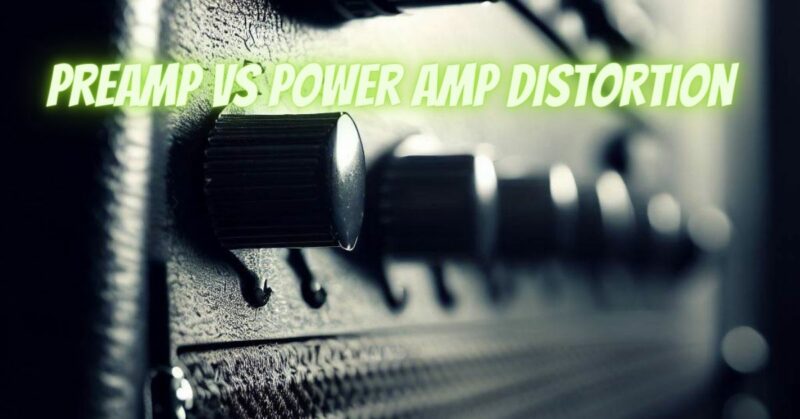Distortion is a beloved aspect of electric guitar tone, adding grit, sustain, and harmonic complexity to the sound. When it comes to achieving distortion in a guitar amplifier setup, understanding the distinctions between preamp and power amp distortion is crucial. In this article, we will delve into the differences between preamp and power amp distortion, exploring their unique tonal characteristics and how they contribute to shaping your overall guitar tone.
Preamp Distortion:
Preamp distortion refers to the distortion generated at the preamplifier stage of a guitar amplifier. It occurs when the preamp’s gain is pushed beyond its clean threshold, resulting in clipping and saturation of the signal. Preamp distortion is often characterized by a compressed and focused tone, emphasizing the harmonics and midrange frequencies. It tends to offer more control over the level of distortion, as many amplifiers provide gain controls on the preamp section. Preamp distortion is commonly associated with classic rock, blues, and heavier genres.
Key Characteristics of Preamp Distortion:
- Harmonic Richness: Preamp distortion tends to emphasize the harmonics and overtones, enhancing the complexity and sustain of the guitar tone.
- Midrange Focus: Preamp distortion often boosts the midrange frequencies, providing a pronounced and focused tone that cuts through the mix.
- Compression: Preamp distortion typically exhibits some degree of compression, resulting in a smoother and more controlled sustain.
Power Amp Distortion:
Power amp distortion occurs when the power amplifier section of a guitar amplifier is pushed beyond its clean operating range. It involves the power amp circuitry overloading and introducing its unique form of distortion to the guitar signal. Power amp distortion is often characterized by a dynamic, punchy, and responsive tone, with emphasis on the low-end frequencies and overall volume. Unlike preamp distortion, power amp distortion is dependent on the amplifier’s overall volume and power level. It is commonly associated with genres such as hard rock, metal, and high-gain playing styles.
Key Characteristics of Power Amp Distortion:
- Dynamic Response: Power amp distortion provides a more dynamic response to the player’s touch and guitar dynamics, with increased sensitivity to picking nuances.
- Enhanced Low-End: Power amp distortion tends to emphasize the low-end frequencies, delivering a fuller and heavier tone.
- Volume-Dependent: Power amp distortion is tied to the overall volume and power level of the amplifier, requiring higher volume settings to achieve noticeable distortion.
| Feature | Preamp Distortion | Power Amp Distortion |
|---|---|---|
| Cause | Poor quality preamp | Poor quality power amp |
| Effect | Introduces noise into the signal | Makes the sound harsh and distorted |
| Prevention | Use a high-quality preamp | Use a high-quality power amp |
Choosing Between Preamp and Power Amp Distortion:
The choice between preamp and power amp distortion depends on personal preferences, playing style, and musical genre. Preamp distortion offers more control and can be achieved at lower volume levels, making it suitable for studio recording and lower-volume performances. Power amp distortion, on the other hand, excels in live performances and situations where high volume and increased low-end response are desired.
Some guitarists prefer combining both preamp and power amp distortion for a more nuanced and layered tone. This can be achieved by driving the preamp gain for initial saturation and then pushing the power amp section for additional grit and sustain.
Conclusion:
Understanding the differences between preamp and power amp distortion allows guitarists to make informed decisions when crafting their desired tone. Preamp distortion offers harmonic richness, midrange focus, and controlled sustain, while power amp distortion provides dynamic response, enhanced low-end, and volume-dependent characteristics. By experimenting with these two types of distortion and finding the right balance, you can discover your own signature sound and create the desired tonal palette for your musical expression.


